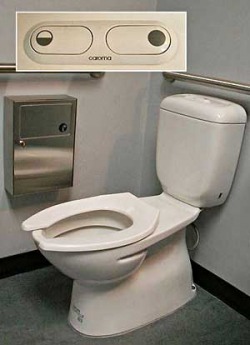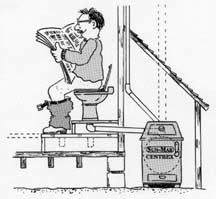Toilets
Dual- Flush Toilets

In a typical residential home the majority of water wasted is in the bathroom, typically the toilet. Early 13 litre and 20 litre toilets have been replaced by building codes requiring 6 litre toilets being installed in all new developments. Although these are far superior to older toilets, there are still large amounts of water literally being flushed away. In the early 1980’s a dual flush toilet was developed to further conserve water. These toilets provided the option of a 3 litre flush for liquid waste or a full 6 litre flush for solid waste. Although the dual flush toilet is mandated in Australia and Singapore, it is still relatively new technology in North America.
Veritec Consulting Inc. and Canada Mortgage and Housing Corporation conducted a study in cooperation with 12 municipalities in Canada to compare the water conservation and cost effectiveness of dual flush toilets versus 6 litre conventional toilets. Dual flush toilets presented a significant water savings over the standard toilets, results showing:
● Flush volumes were reduced by 68 per cent in single-family dwellings, 56 per cent in office washrooms, and 52 per cent in the participating restaurant.
● Dual-flush toilets were found to save an average of 26 per cent more water than the single-flush 6-litre toilets.
Providing a toilet rebate program or promoting the environmental and cost benefit of dual flush toilets could have a significant impact on water conservation and is a method that should be discussed for the Village of Dunnottar.
References:
Canada Housing and Mortgage Corporation., Veritec Consulting Inc. 2002. Dual Flush Toilet Testing. Technical Series 02-124. www.cmhc-schl.gc.ca/publications/en/rh-pr/tech/02-124-e.html
Photo: http://www.portlandonline.com/water/index.cfm?a=bcjede&c=egcgd
Composting Toilets

Composting toilets use natural soil organisms to breakdown ‘blackwater’ or human wastes. They are waterless and therefore remove 30-40% of the water normally allocated per household just for flushing the toilet, a savings of approximately 283,905 liters of water per year (Walker, 2005). This also means reduced septic loads (Kwok et al, 2007).
The end product called ‘humus’ is a high quality fertilizer that can be used as soil around any non-edible trees or gardens (Envirolet, 2007). The composter works the same way as any backyard composter does, you can also put most of your household compostables into the toilet such as food scrapes, paper, and lawn clippings (Ibid).
Composting toilets largely reduce the nutrient load by removing the ‘blackwater’ from household effluents (Envirolet, 2007). This leaves the majority of remaining effluent as greywater which can also be recycled and used in greywater systems as mentioned on this page. The reduction in the nutrient load also means less nitrogen and phosphorus in the lagoons, and fewer nutrients contributed to the lake (Ibid). This means that you will be helping more oxygen content be available in Lake Winnipeg by installing a composting toilet.
References:
Kwok, A.G. & Grondzik, W.T. (2005). The Green Studio Handbook: Environmental Strategies for Schematic Design (p.229-232). Oxford: Elsevier.
Walker, Esmay. (2005). Water Saving Toilets: Greening your home doesn't have to be dirty work with these eco-loo ideas. Avaliable online: http://www.theecologist.org/archive_detail.asp?content_id=570
Envirolet. (2007). The Benefits of Composting Toilets. Avaliable online: http://compostingtoilet.org/compost_toilets_explained/the_benefits_of_composting_toilets/index.php
Photo: http://www.polarwatersystems.com/faq.htm
